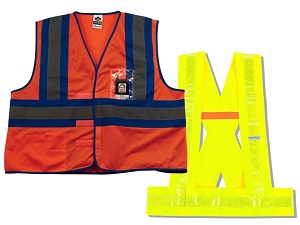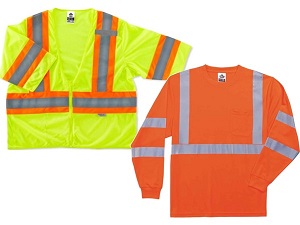The safety of workers in a work zone is just as important as the safety of those using the roadway. Even with the best planning and most comprehensive temporary traffic control (TTC) devices in place, workers must be visible to oncoming traffic or risk deadly consequences.

If workers are exposed to the dangers of traffic and construction equipment in a work zone, they must wear high-visibility safety apparel (HVSA). Whether working day or night, HVSA provides safety by grabbing the attention of motorists, and equipment operators, to ensure they notice the crew members working in or near the work zones.
ANSI/ISEA 107-2015 Foreword The need to be seen is recognized as a critical issue for worker safety. Low visibility is a serious hazard for all workers who must perform tasks near moving vehicles or equipment. Workers must be visible to vehicle operators in all lighting conditions and against complex environmental backgrounds. The sooner a vehicle operator sees a pedestrian worker, the longer the operator has to avoid an incident. High visibility safety apparel and accessories dramatically enhance worker visibility.
HVSA is classed by the Garment Type and Performance Class. All types of HVSA provide daytime and nighttime enhancement that allow workers to be more easily seen on the job site.
An easy way to remember: Type O = Off-Road and Type R = Roadway
Class 1 provides the minimum amount of high-visibility required while Class 3 provides the highest level of visibility provided by a HVSA garment.

For workers that may be in an off-road or non-roadway area, Class 1 (Type O) HVSA is acceptable.
Class 1 apparel provides the minimum amount of high-visibility material provided on ANSI-rated performance class HVSA. In situations where the struck-by hazards in the work area are not approaching at roadway speeds, the visibility distance required can be shorter than is required in TTC zones.

MUTCD Standard 6D.03-04 All workers within the right-of-way who are exposed to either traffic or to work vehicles and construction equipment within the TTC zone shall wear high-visibility safety apparel that meets the Performance Class 2 or 3 requirements of the ANSI/ISEA 107 publication.
Class 2 (Type R) high-visibility safety apparel is considered the minimum level of protection for workers exposed to the roadway and TTC zones.
Class 2 apparel uses more high-visibility materials than Class 1 that allow for the worker to be identified from farther away, ultimately providing for a higher level of safety.
Based on the ANSI guidelines, Class 2 garments shall have at least one horizontal band of reflective material around the torso, and at least the minimum amounts of reflective material in the shoulder area and/or around the sleeves.

Class 3 (Type R) high-visibility safety apparel offers the highest level of protection for workers exposed to the roadway and TTC zones.
Class 3 apparel uses even more high-visibility materials than Class 2 that allow for the worker to be identified more quickly, from a greater distance, providing for a higher level of safety.
Based on the ANSI guidelines, these Class 3 garments shall have one or more bands of reflective material around the torso as well as one or more reflective bands on the sleeves.
A safety vest without sleeves does not offer Class 3 protection.

When selecting high-visibility safety apparel to be worn in temporary traffic control zones, ensure the garment comes from a reputable dealer with a tag that is clearly printed and easily readable indicating that the apparel meets ANSI/ISEA 107 Class 2 or Class 3 requirements.
ANSI/ISEA 107-2015 6.2.1 HVSA shall be designed to permit maximum visibility of the wearer. The most effective deployment of high-visibility materials on a garment is distribution at the ends of the limbs to mark the human form and accentuate human motion.
High-visibility safety apparel should always be replaced if the item becomes faded or damaged. Most HVSA that is worn on a daily basis will last approximately 6 months, but if the garment is not worn every day, it could last up to 3 years.
Always refer to the manufacturer’s recommendations for laundering and replacing HVSA to ensure the work apparel is providing maximum safety.

.jpeg)

.jpg)